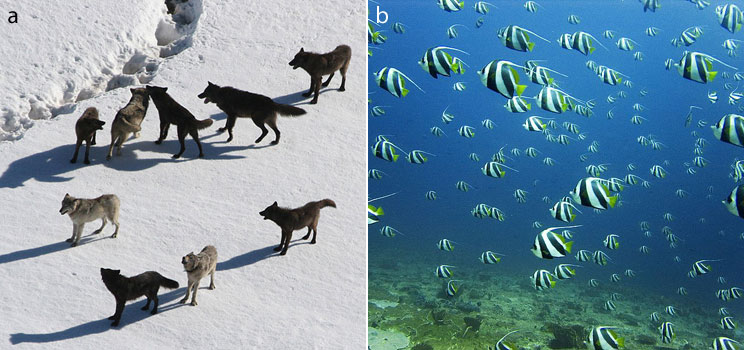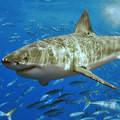Which Of The Following Occurs Within One Individual Animal's Lifetime?
Why do animals help others at the potential toll of their own survival and reproduction?
Social behavior consists of a fix of interactions among individuals of the same species. A wide range of sociality occurs among animals. Some animals rarely if ever interact with one another, even when it comes to bug of parental care. Examples of relatively asocial animals include mosquitoes and polar bears. Highly social organisms alive together in large groups, and often cooperate to acquit many tasks. Examples of social groups include packs of wolves and schools of fish (Figure 1). The near highly social animals form tightly knit colonies and include all ants and termites, some bees and wasps, and a few other organisms.

Figure ane: Social groups which have formed to improve the probability of survival and reproduction of individual members: pack of wolves (a) and school of fish (b)
Social Behavior is Adaptive
Many social behaviors of animals are adaptive, pregnant that existence social ultimately increases an animal's fettle — its lifetime reproductive success. One example of how social behavior is adaptive is aggregation against predators. This concept applies to caterpillars feeding together on a leaf, a herd of wildebeest, schools of fish, and flocks of birds.
A landscape filled with lonely wildebeest will offering easy pickings for big predators such as lions (Effigy ii). If the wildebeests gather into a single group, then the risk of any single individual being eaten is reduced. In the circumstance of an set on by a predator, the odds of one individual being targeted are 100% for solitary individuals, 1% in a group of 100, and 0.1% in a group of 1000. Wildebeests practice endure social costs from aggregating in groups — grazing sites may not provide acceptable food for every individual in the group, for example. However, it is not difficult to imagine that the costs of social aggregation are much smaller than the benefits of the defence against predation. This is a simple example of how the costs and benefits of social beliefs may evolve and exist maintained.

Figure two: Wildebeests gathered into groups are more protected from predators than any solitary wildebeest.
Living in groups involves a balance of conflict and cooperation, which is mediated past the costs and benefits associated with living socially. When the benefits of living socially exceed the costs and risks of social life, scientists predict that social cooperation will be favored.
Altruism
The benefits of social life typically occur when one individual is the benefactor of an act of altruism. An altruistic human activity is one that increases the welfare of another individual at an actual or potential cost of the private who performs the human activity.
An example of altruism comes from ground squirrels, who may warn other members of their group almost a predatory hawk overhead. This brings the hawk's attention to the individual giving the alert phone call. This risky behavior benefits other individuals in the squirrel'south group. Other examples of donating beliefs include sharing nesting infinite and helping to heighten offspring of an unrelated individual.
The do good of an donating beliefs is ultimately measured in its effect on an animal's lifetime reproductive success. Evolutionary biologists and animal behaviorists have sought to identify the mechanisms that tin can explain what some have chosen the "problem of altruism." Natural selection operates against individuals who reduce their own fitness. Altruism by definition decreases the fitness of the individual, so how can this behavior persist? The solution to the "trouble" of altruism comes from decades of enquiry into genetics and beast behavior, which has taught us that altruism is a powerful demonstration of natural selection at piece of work.
Reciprocity
Vampire bats (Effigy 3) returning from an unsuccessful foraging bout will beg to share food from successful individuals. It is well-nigh straight in the involvement of the solicited bat to continue its own food, as it requires the nutrients to survive and reproduce, and giving upwardly office of its meal is in fact altruistic. Thus in both ecological and evolutionary terms, other members of this bat'south ain species are its greatest competitors.

Figure 3: A vampire bat, an fantabulous model system to test theories regarding the altruistic sharing of food
So why would a vampire bat share its meal of blood? The answer is reciprocity. In the early 1980s, graduate student and researcher Gerald Wilkinson conducted a serial of experiments to demonstrate that vampire bats in Costa Rica oftentimes shared claret with other bats sharing their roosts. He establish, however, that bats did not share their meals with all other bats as.
Why would bats not share food equally? Based on long-term measurements of bat movements among roosts, Wilkinson found that some bats were more likely to interact with sure individuals more than others. Bats were far more likely to share blood with bats they were more likely to encounter in the future. In other words, when in that location was a greater opportunity for reciprocation, the bats were more likely to share their meals. Bats would not share blood meals with other bats if there was petty take chances that the other private would be able to render the favor.
Reciprocity enables the existence of altruism because — in the long term — the benefits of altruism can outweigh the costs of altruism. In this particular example, the relative cost of sharing food, when bachelor, is less than the potential future benefit of receiving food when hungry.
Kin Option
Vampire bats share nutrient not only because of the apprehension of reciprocation. They are far more likely to share claret meals with their relatives. After taking into business relationship the potential for reciprocity, vampire bats are more inclined to share their blood meals with kin than with unrelated individuals. Using genetic analyses, researchers tin calculate the relatedness among individuals. Bats that are more than closely related are more likely to share resource.
Why are relatives more than likely to exist the recipients of altruistic acts than not-relatives? Individuals are far more likely perform donating acts for siblings than for nephews, and even less likely for third cousins. The mechanism behind the effect of relatedness on altruism is kin selection. Natural selection reflects how an individual passes on copies of their own genes through survival and reproduction, but kin selection reflects how copies of an individual's genes are passed down through the survival and reproduction of their relatives. Merely every bit the principle of natural pick predicts that an individual volition act to maximize their own fettle, the principle of kin selection predicts that an private will act altruistically to maximize the fitness of its relatives.
There are limits to altruism. An private'south direct fitness is measured past copies of her own genes passed on to children, grandchildren, then on, whereas indirect fitness is the measure of copies of her genes passed on through her non-descendant relatives such every bit cousins, nieces, nephews, and siblings. Pick will favor an donating act if the benefit of the deed (in terms of indirect fettle) exceeds the cost of the act (in terms of directly fitness). When individuals are more than closely related, they have a greater relatedness (r) and altruism is more probable to occur. Relatedness is measured on a scale from 0–1 because it reflects the proportion of genes that are shared by 2 individuals. Zero indicates no relation amid individuals. The coefficient r every bit measured in other pairs includes full siblings: 0.5; parent-offspring: 0.5; grandparent-grandchild: 0.25; cousins: 0.125.
In the 1960s, W. D. Hamilton formulated what is at present normally known equally Hamilton'south rule, in which relatedness is shown to moderate the probability that altruistic acts will occur. According to Hamilton's rule, altruism is favored when the benefits (B) of the altruistic act to the recipient, multiplied by the relatedness (r) to the actor, exceed the costs (C) to the role player; this is expressed mathematically as rB > C. In add-on to vampire bats, other species such as footing squirrels, paper wasps, and wild turkeys follow Hamilton's rule.
Eusociality
The development of social behavior at its most intimate and complex degree is found in eusocial animals. Eusocial species alive in colonies. Only a relatively small fraction of the animals in the colony reproduce; the non-reproductive colony members provide resource, defense, and collective care of the young. The listing of known eusocial animals includes ants, termites, some wasps, some bees, a small number of aphid and thrip species, two species of mammal (the naked mole rat and the Damaraland mole rat), and multiple species of reef-home shrimp.
How can selection produce an organism that has no hazard of reproducing independently, whose fitness is entirely invested into colony mates? In other words, how can animals take no direct fitness and only indirect fitness? Individuals in colonies are unremarkably related to 1 some other, and relatedness can even be greater than 0.5 as a effect of the unique genetics of some groups of insects or inbreeding (mating betwixt close relatives). Hamilton's rule and kin selection provide at to the lowest degree a partial explanation for the development of eusociality.
An ecological explanation for the development of eusociality is that colonies often produce a very big number of offspring, such that fifty-fifty when relatedness is depression the indirect fitness of the not-reproductive workers may be greater than if they had the capacity to reproduce independently. In eusocial animals, the high productivity resulting from communal life and the efficient division of labor amidst workers takes place in an environment which is commonly well defended against natural enemies (Figure 4). In nigh all eusocial species, colonies are protected through structural means (such as termite nests in wood, or shrimp in marine sponges), with venom (of wasps, bees, and ants), or by both means.

Figure 4: Social insects have well protected or defended nests, including termites (a), wasps (b), and bees (c).
Summary
Social and altruistic behaviors crave a broad view of Darwinian fitness and an understanding that animals can perform behaviors that are responsive to short-term and long-term consequences for their fitness. By conducting enquiry into how organisms interact with their surroundings and how the surround is predictive of their survival and reproductive success, researchers are able to explain how social behavior has evolved via the mechanism of natural selection.
References and Recommended Reading
Hamilton, W. D. The genetical evolution of social behaviour. International Journal of Theoretical Biology 7, 1-xvi (1964).
Sherman, P. Due west. Nepotism and the evolution of warning calls. Science 197, 1246-1253 (1977).
Wilkinson, M. S. Reciprocal food sharing in the vampire bat. Nature 308, 181-184 (1984).

This content is currently under construction.
Topic rooms within Animal Beliefs
Close
No topic rooms are at that place.


- | Pb Editor: Sara Tenney
Source: https://www.nature.com/scitable/knowledge/library/how-does-social-behavior-evolve-13260245/
Posted by: jonesvoill2001.blogspot.com

0 Response to "Which Of The Following Occurs Within One Individual Animal's Lifetime?"
Post a Comment